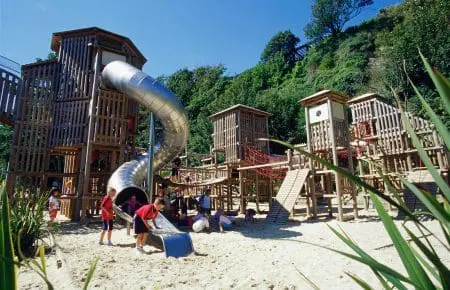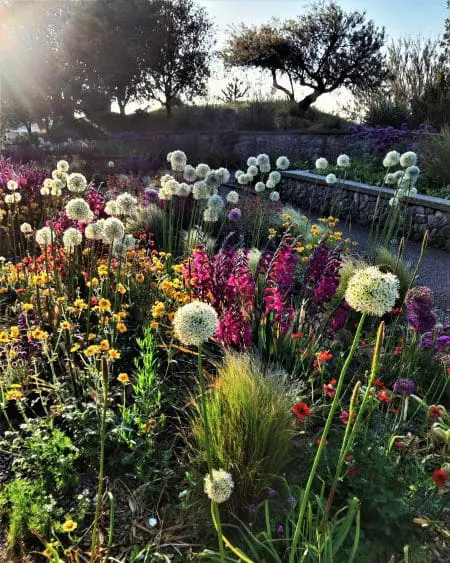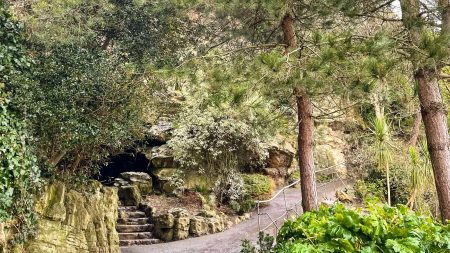LOWER LEAS COASTAL PARK
THE JEWEL IN FOLKESTONE’S CROWN
Tucked in beneath the Leas at Folkestone, between the town and the sparkling English Channel, is the Leas Coastal Park – a fantastic blend of fun, formal gardens and flora and fauna.
THE FUN ZONE
Where better place to start than the South East’s largest free adventure playground?
Fun with a capital F, the area includes a sunken pirate ship, zip lines and over 12m of tube slides, and is designed specifically for inclusive play, with low level play panels and easy wheelchair accessibility.
Other attractions include climbing walls, a toddler construction area, sand diggers, and a harbour with rocking boats. There’s also plenty of seating for the grown-ups, and the Mermaid Café for those essential teas, coffees and snacks… The only problem may be convincing the little darlings that it’s time to go!
The Fun Zone is also home to a 350 seat amphitheatre. This is the venue for a programme of free events every summer, ranging from music and magic to comedy and drama, storytelling, participative art and much more. It’s also the starting point for guided walks around the park, and where you can access the Zig Zag Path.


THE FORMAL GARDENS
A gentle stroll through the Formal Gardens will take you back to Victorian times, when genteel ladies and their beaux would “take the air” and perhaps flirt a little under the wide avenues of pine trees, just as long as the young ladies’ chaperones couldn’t hear the whispered words.
The planting has been carefully chosen to reflect the Park’s history, provide year round interest, and resistance to dry conditions and the salty air. The formal planting style offers a contrast between the Fun Zone and the Wild Zone, making a visit to the Lower Leas Coastal Park a real kaleidoscope of experiences.
THE WILD ZONE
Or you could say “Where the wild things are”… The Wild Zone is home to a rich blend of flora and fauna, particularly for migrating birds and insects, and it has an unusual mild microclimate and thin sandy soil which is ideal for seaside plants. Sensitive habitat management by the Folkestone & Hythe District Council Grounds Maintenance Team continues to ensure that wildlife is happy here, and it’s a haven for us to enjoy the peace while seeing what we can spot. On our list are butterflies, bees, woodpeckers and blue tits – what will you see?
HISTORY
The Park wouldn’t be there at all if it wasn’t for a spectacular landslip in 1784. In 1828 landowner the Earl of Radnor (whose name is seen all over Folkestone) built a toll road along the land, creating an easy and profitable route between Folkestone Harbour and Sandgate.
1843 saw the arrival of the railway, transforming Folkestone from a small fishing port into a popular resort with visitors from London, including Edward, Prince of Wales. “Taking the air” was a fashionable activity, and so tea rooms, shelters and woodland walks were created to complement the newly planted holm oaks and pine trees.
The first Leas Lift opened in 1885 and proved so popular that a second was added in 1890. There was also a lift serving the Metropole Hotel, and yet another connecting the western end of the Leas with Sandgate (both no longer in existence, although you can see the remains of the Metropole lift).
After World War I unemployment was hitting the country, and so those out of work were set to work building the Zig Zag Path in 1921. The incredibly natural-looking cliff face and grottoes are actually built mostly from waste material and coated in a special cement called Pulhamite after its creator James Pulham. Now a listed structure, the path is one of the country’s finest examples of his work.
PRACTICALITIES
Lower Leas Coastal Park
Lower Sandgate Road Folkestone
CT20 2JP
Parking: folkestone-hythe.gov.uk/parking/car-parks-in-district
Toilets: folkestone-hythe.gov.uk/parks-beaches-open-spaces/publictoilet-facilities
Dogs: Allowed on leads.
Barbecues are not allowed in the park.
